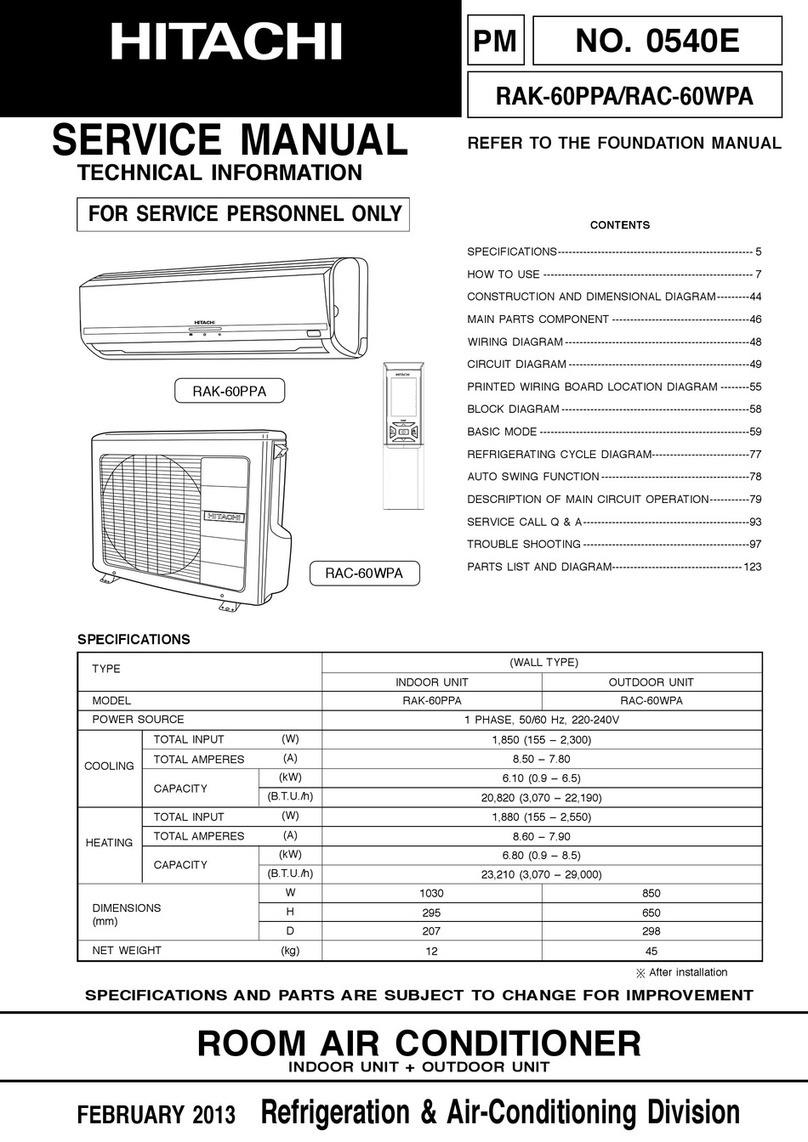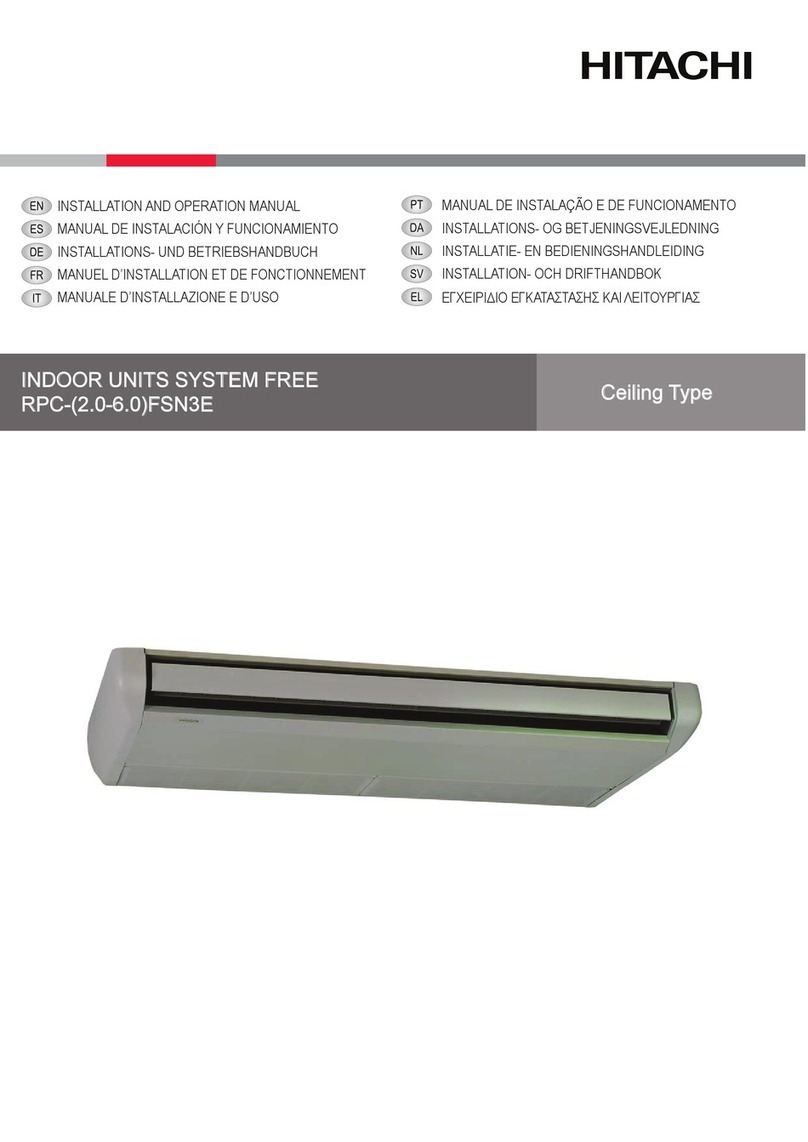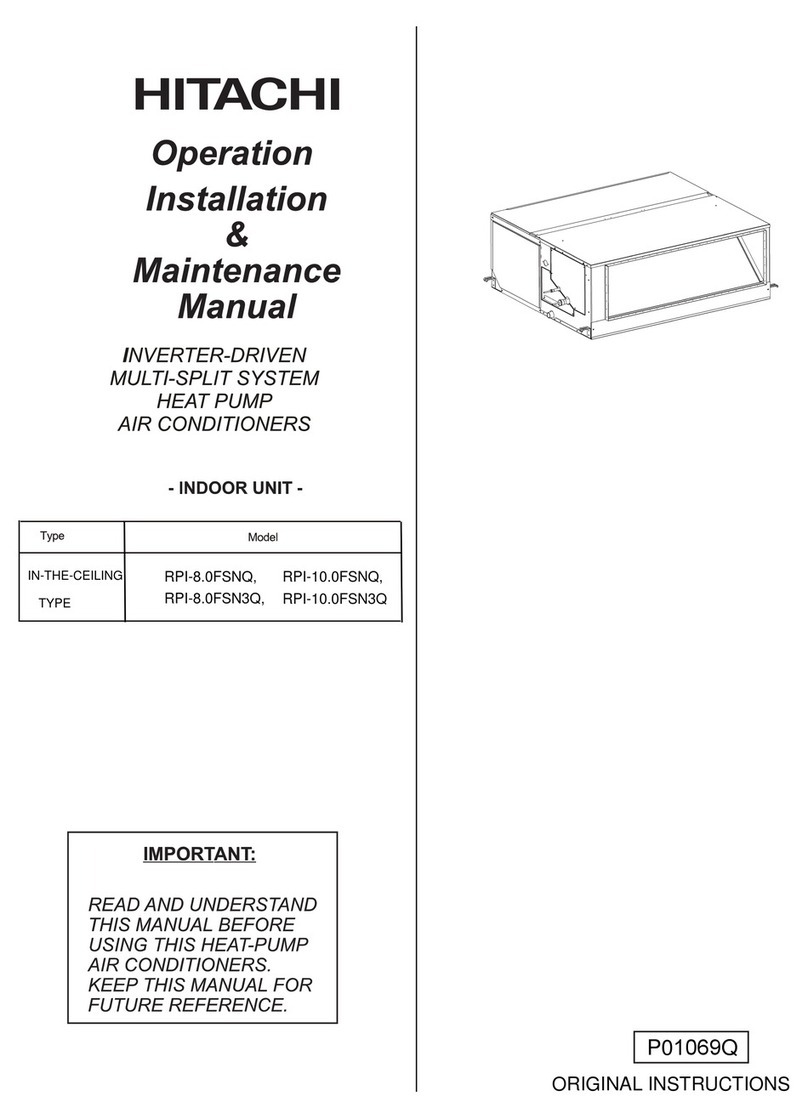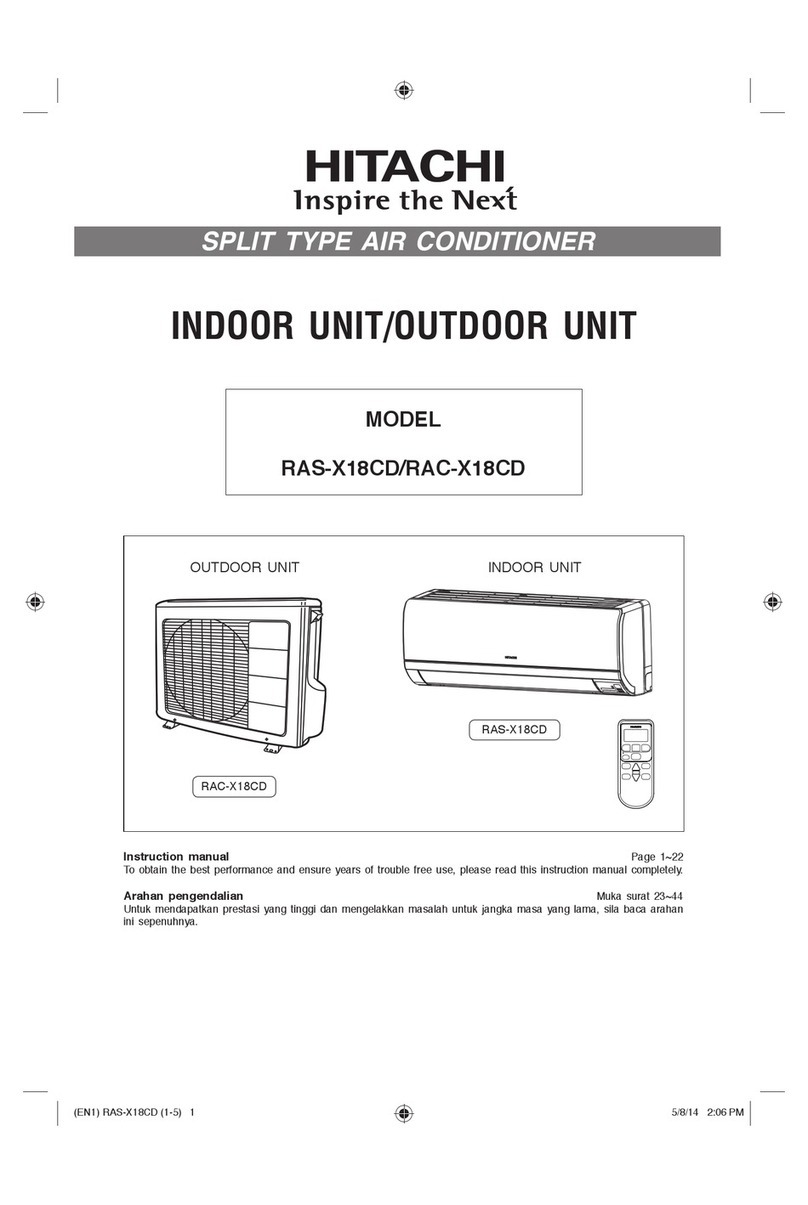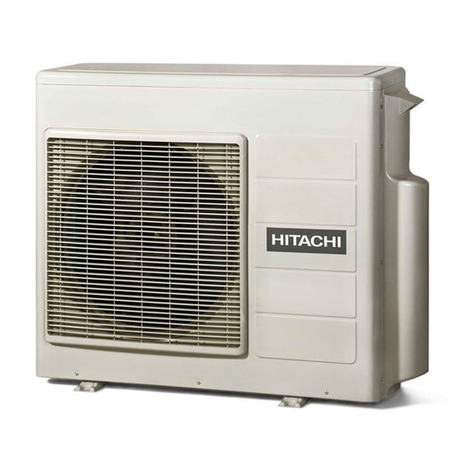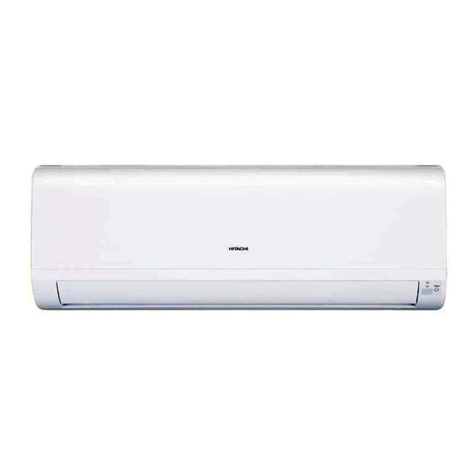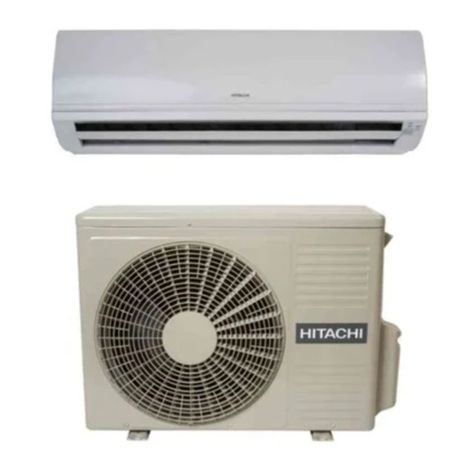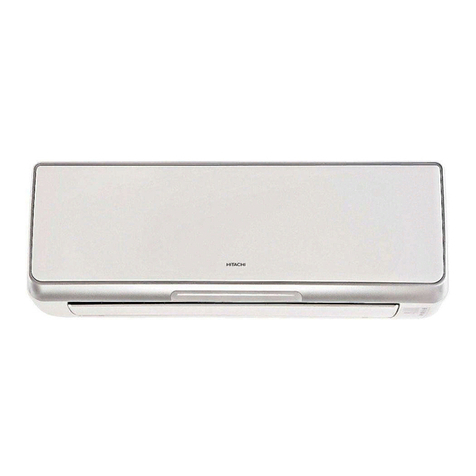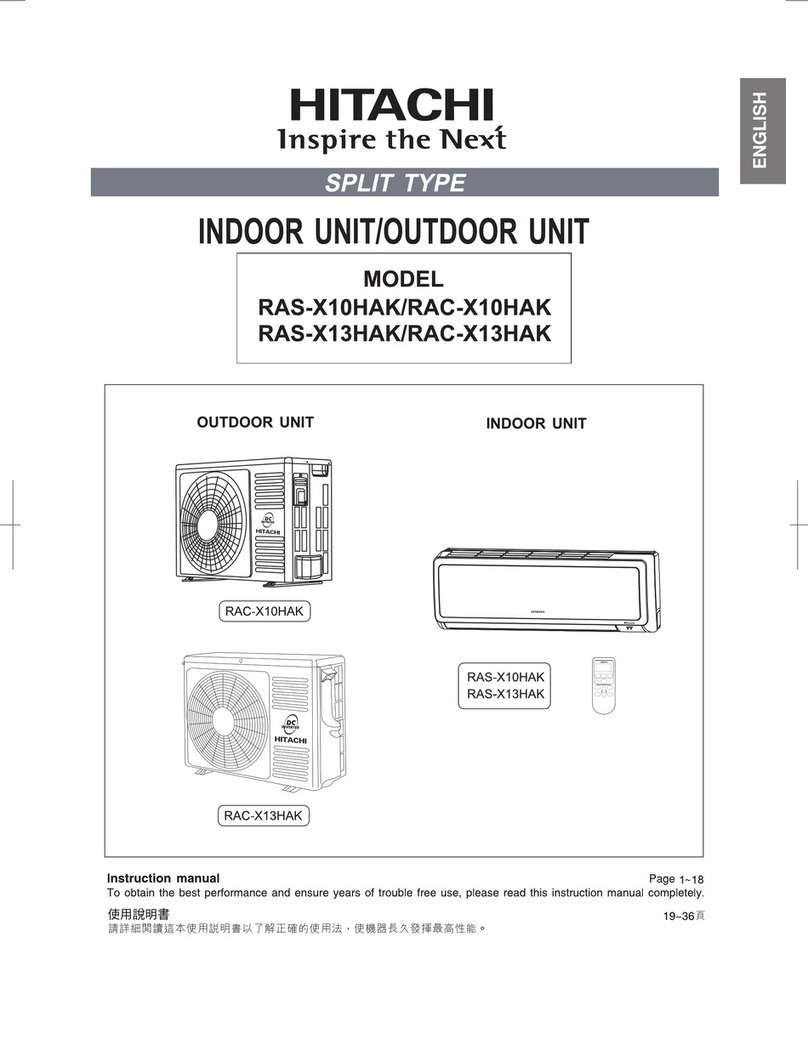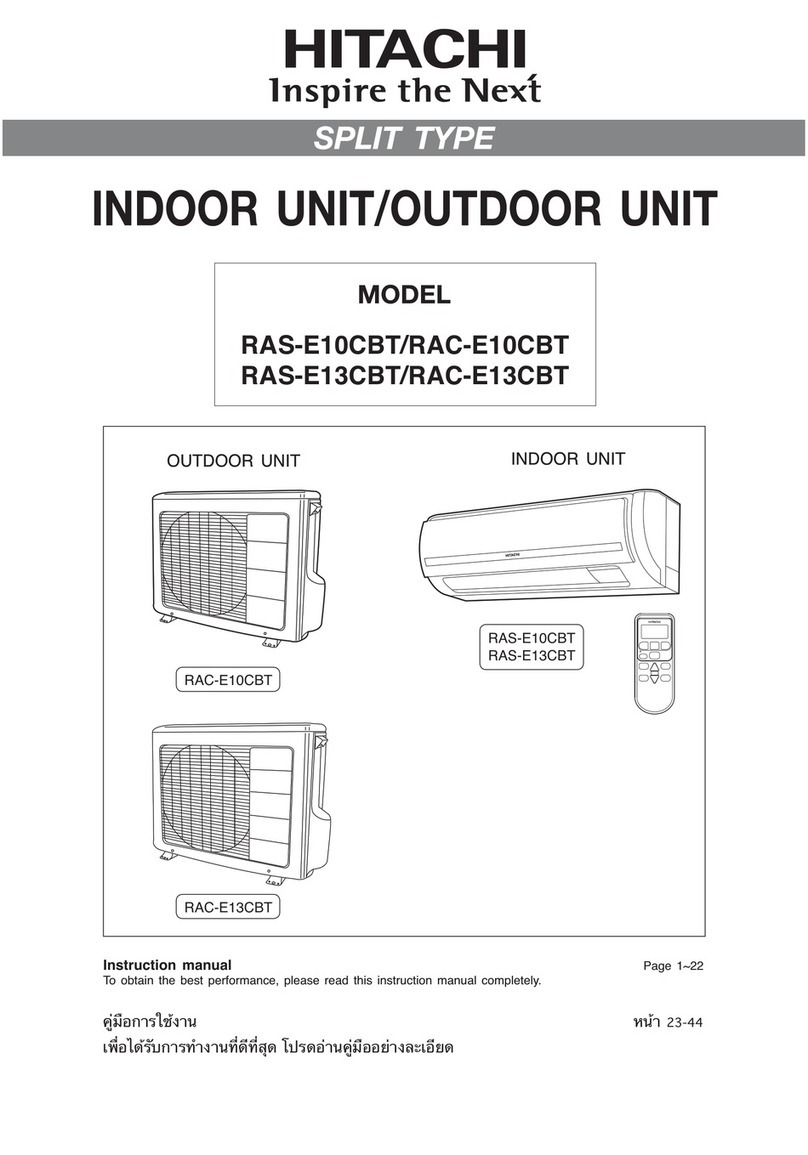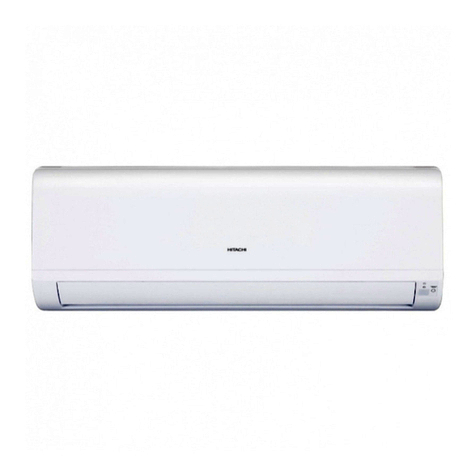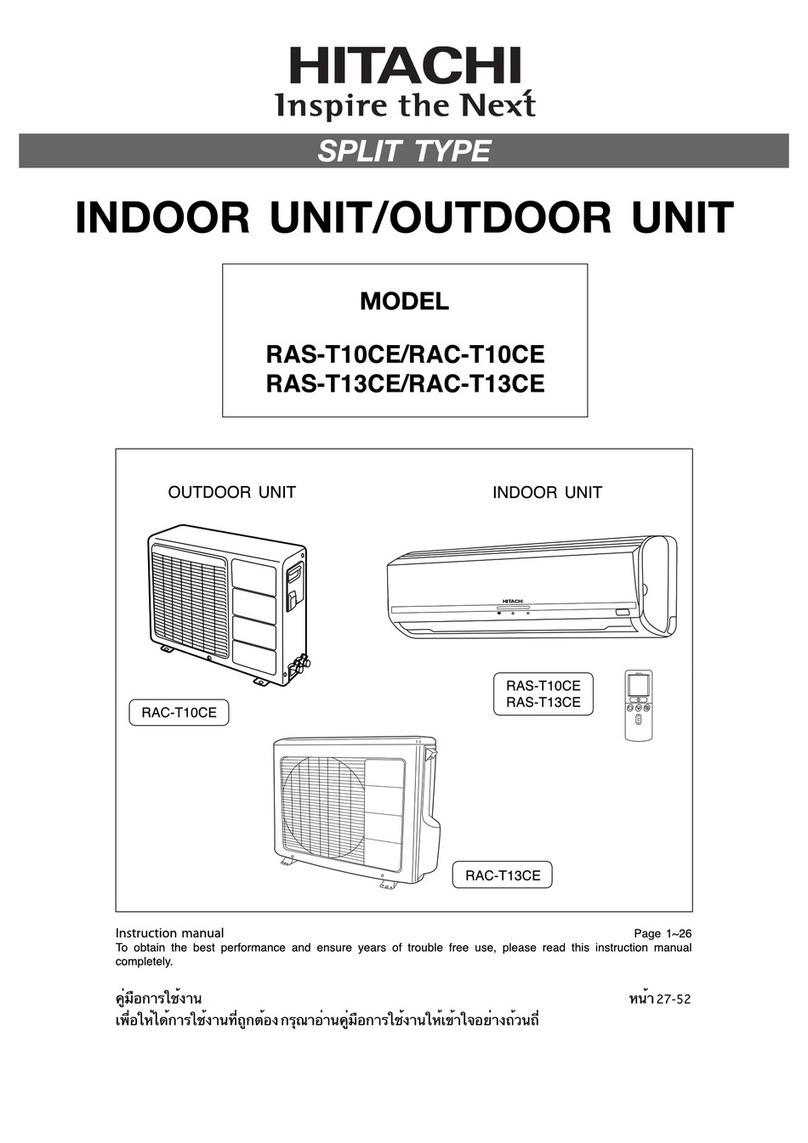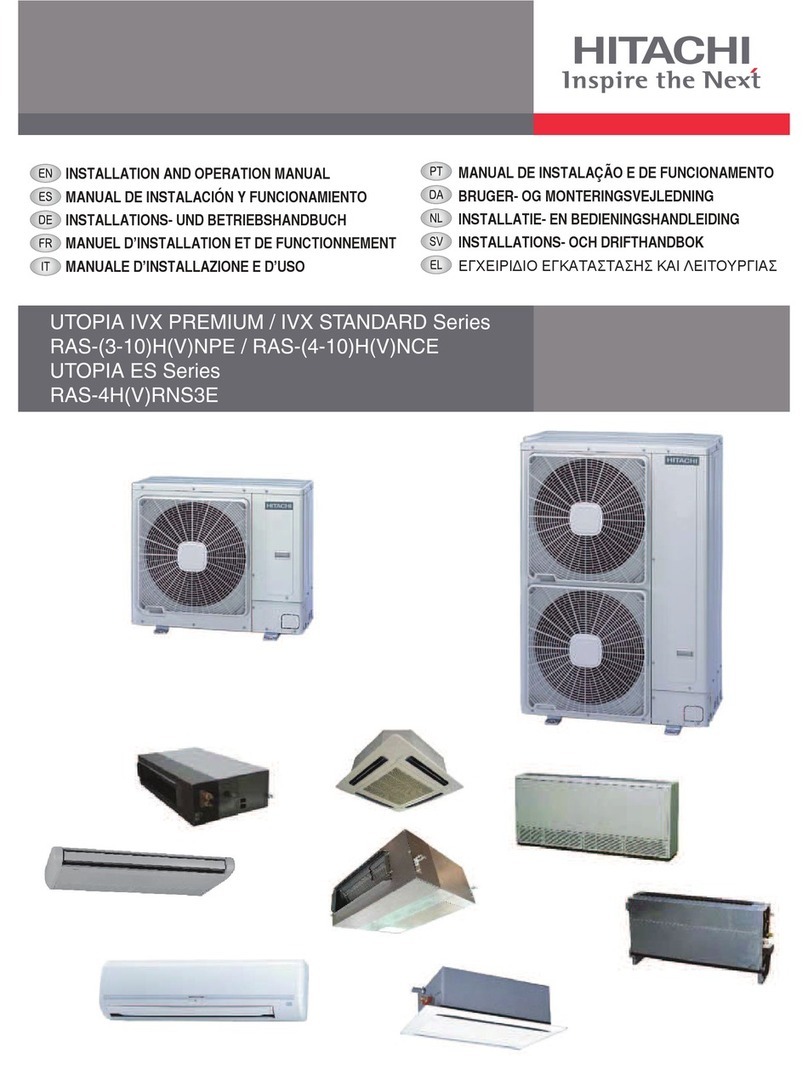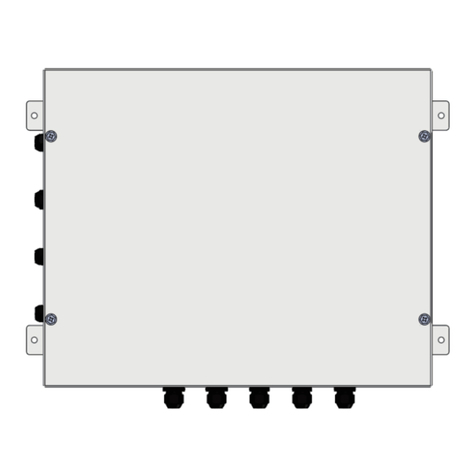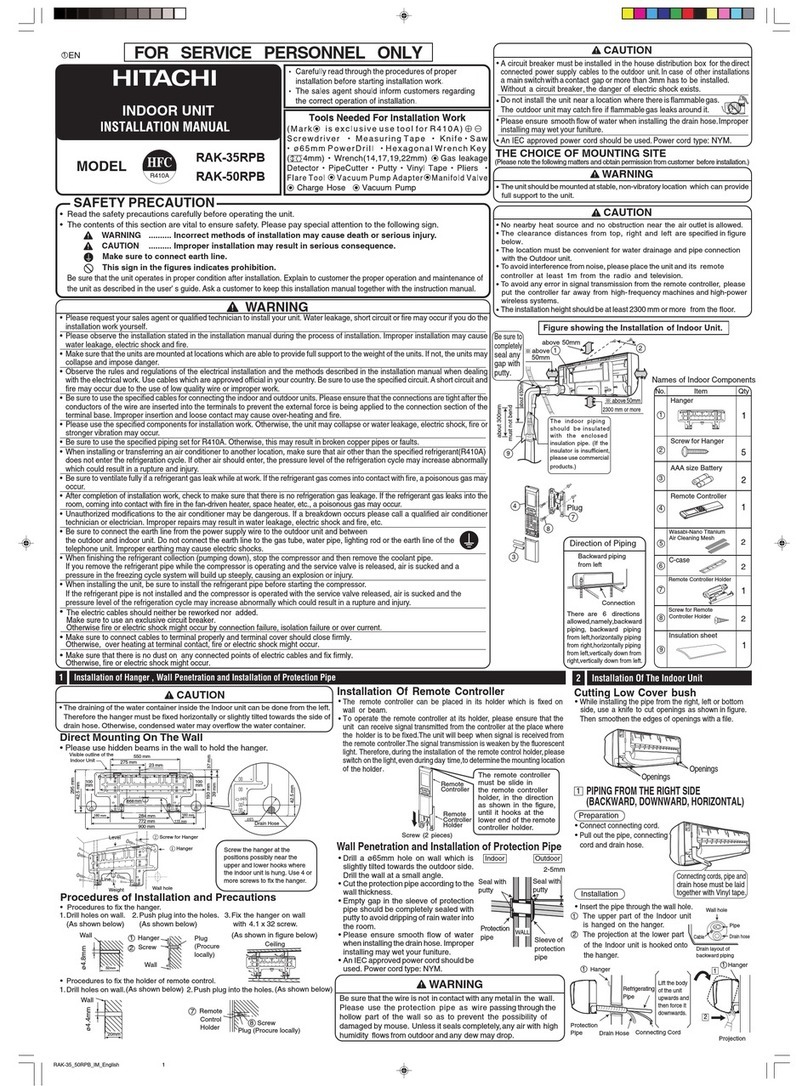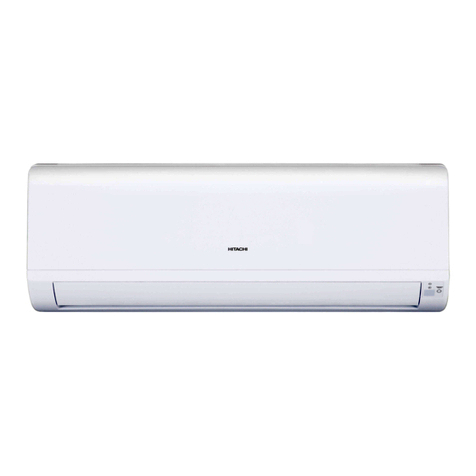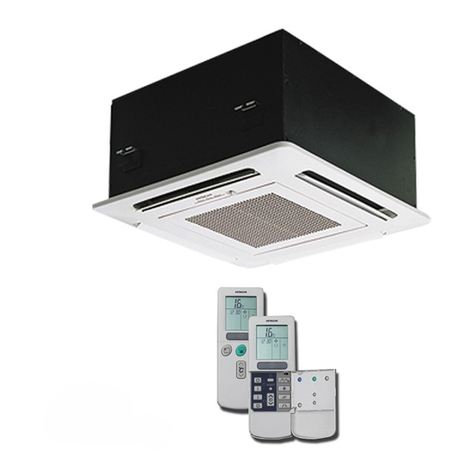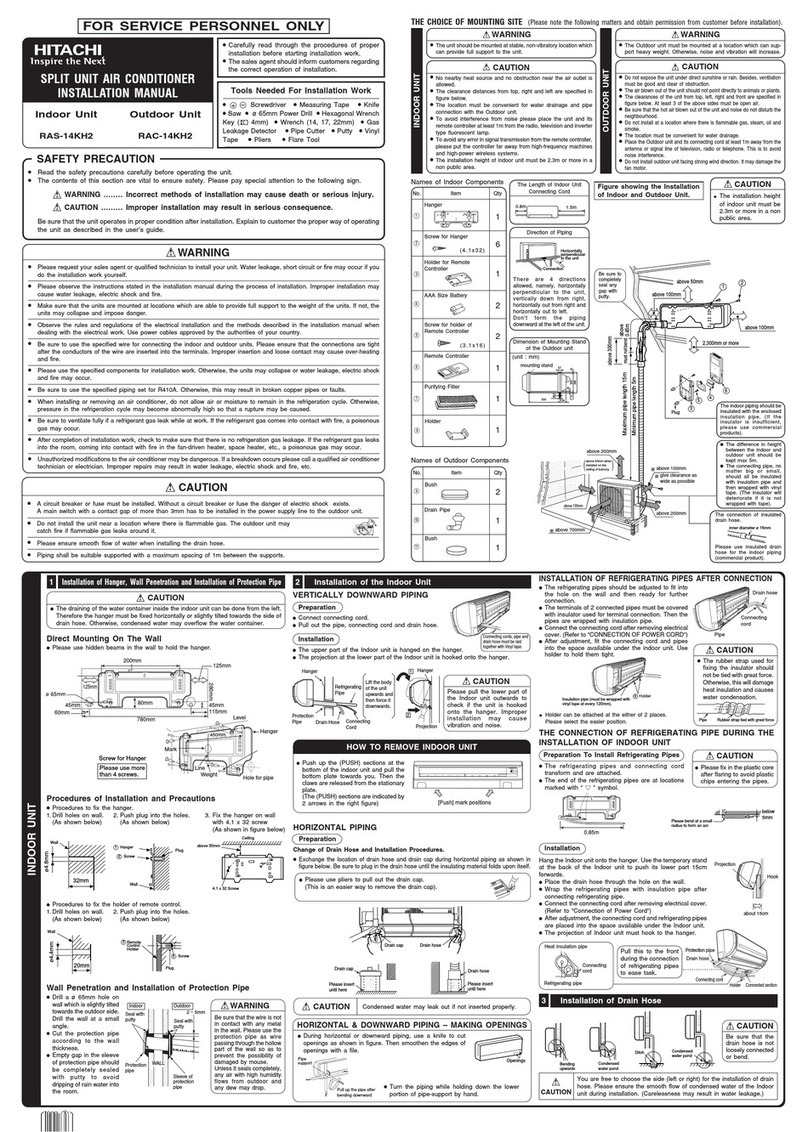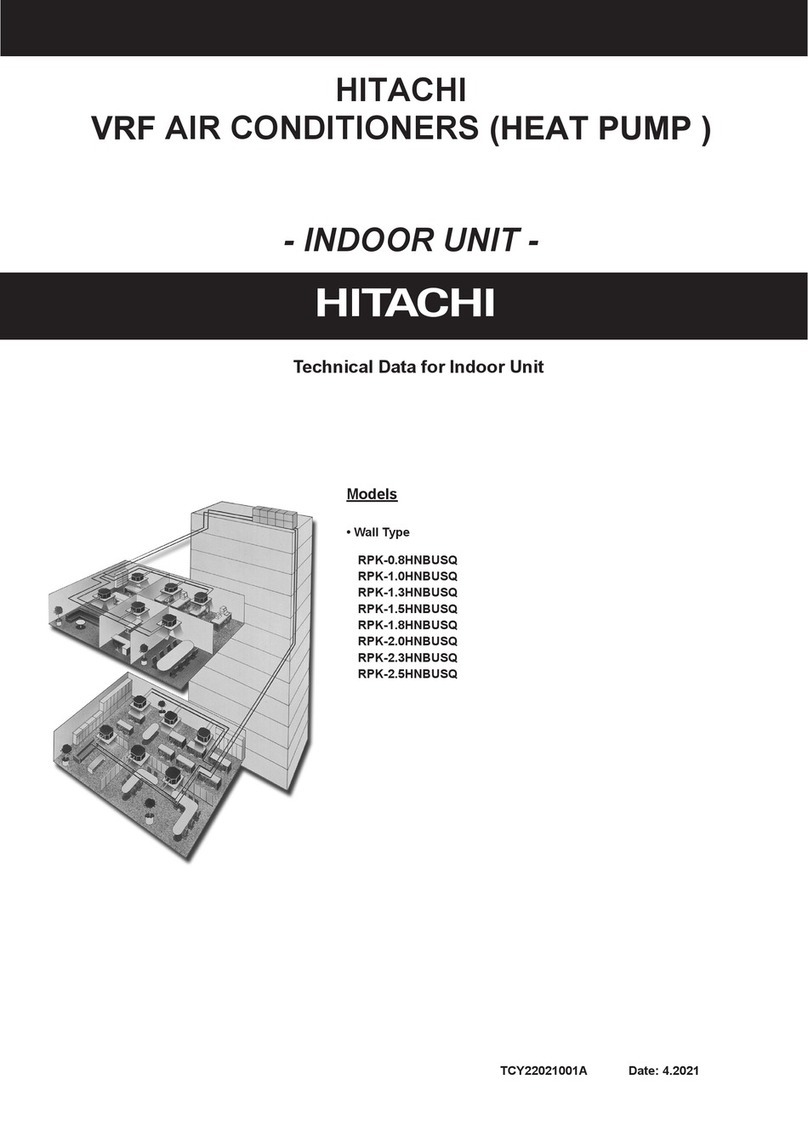!
!
!
!
<
IA669: A
>
!
THE CHOICE OF MOUNTING SITE (Please note the following matters and obtain permission from customer before installation).
WARNING
!
OThe unit should be mounted at stable, non-vibratory location which can
provide full support to the unit.
WARNING
!
O
The Outdoor unit must be mounted at a location which can support heavy weight.
Otherwise, noise and vibration will increase.
!
O
No nearby heat source and no obstruction near the air outlet is allowed.
O
The clearance distances from top, right and left are specied in gure below.
O
The location must be convenient for water drainage and pipe connection with
the Outdoor unit.
O
To avoid interference from noise please place the unit and its remote controller
at least 1m from the radio, television and inverter type uorescent lamp.
O
To avoid any error in signal transmission from the remote controller, please put
the controller far away from high-frequency machines and high-power wireless
systems.
O
The installation height of indoor unit must be 2.3m or more.
CAUTION
!
O
Do not expose the unit under direct sunshine or rain. Besides, ventilation must be
good and clear of obstruction.
O
The air blown out of the unit should not point directly to animals or plants.
O
The clearances of the unit from top, left, right and front are specied in gure
below. At least 3 of the above sides must be open air.
O
Be sure that the hot air blown out of the unit and noise do not disturb the
neighbourhood.
O
Do not install at a location where there is ammable gas, steam, oil and smoke.
O
The location must be convenient for water drainage.
O
Place the Outdoor unit and its connecting cord at least 1m away from the antenna
or signal line of television, radio or telephone. This is to avoid noise interference.
O
Do not install outdoor unit facing strong wind direction. It may damage the fan
motor.
INDOOR UNIT
OUTDOOR UNIT
CAUTION
!
!
Other optional parts for display panel
& wireless remote control SPX-RCK4
Display panel
Panel installation plate
Panel cover
Remote controller
(wireless)
Holder for remote control
3.1 x 16 scr
ew
Item
Quantity
No.
1
2
3
4
5
6
1
1
1
1
1
2
1
2
3
4
5
6
7
8
9
10
11
12
13
14
15
16
17
18
HITACHI CEILING CASSETTE-UNIT AIR
CONDITIONER INSTALLATION MANUAL
Maximum pipe length 50m
Minimum pipe length 5m
Above 100mm
give clearance
as wide as
possible
Above 200mm
Above 50mm when
installed on the
ceiling of balcony
Above 200mm
Above 100mm
Above 500mm
Air
outlet
Air
outlet 1000 mm
or more
1000 mm
or more
Air inlet
300 mm
or more
Air
outlet
Air
outlet
1000 mm
or more
1000 mm
or more
Air inlet
2500 mm
or more
O Carefully read through the procedures of proper installation
before starting installation work.
O The sales agent should inform customers regarding the correct
operation of installation.
FOR SERVICE PERSONNEL ONLY
Tools Needed For Installation Work
O+ – Screwdriver OMeasuring Tape OKnife OSaw
Oø 65mm Power Drill OHexagonal Wrench Key ( 4mm)
OWrench (14,17,19,22,26,27mm) OGas Leakage Detector
OPipe Cutter OVinyl Tape O Pliers OFlare Tool
ORead the safety precautions carefully before operating the unit.
OThe contents of this section are vital to ensure safety. Please pay special attention to the following sign.
WARNING ........ Incorrect methods of installation may cause death or serious injury.
CAUTION ......... Improper installation may result in serious consequence.
Be sure that the unit operates in proper condition after installation. Explain to customer the proper way of operating the unit as
described in the user’s guide.
WARNING
OPlease request your sales agent or qualied technician ti install your unit. Water leakage, sort circuit or re may occur if you do the
installtion work yourself.
OPlease observe the instructions stated in the installation manual during the process of installation. Improper installation may cause
water leakage, electric shock and re.
OMake sure that the units are mounted at locations which are able to provide full support to the weight of the units. If not, the units
may collapse and impose danger.
OObserve the rules and regulations of the electrical installtion and the methods described in the installation manual when dealing
with the electrical work. Use power cables approved by the authorities of your country.
OBe sure to use specied wire for the connection indoor and outdoor units. Please ensure that the connections are tight after the
conductors of the wire are inserted into the terminals. Improper insertion and loose contact may cause over-heating and re.
OPlease use the specied components for installtion work. Otherwise, the units may collapse or water leakege, electric shock and
re may occur.
OBe sure to use the specied piping set for R-22. Otherwise, this may result in broken copper pipes or faults.
OWhen installing or removing an air conditioner, only specied refrigerant (R-22) shall be allowed, do not allow air or moisture to
remain in the refrigeration cycle. Otherwise, pressure in the refrigeration cycle may become abnormally high so that a rupture may
be caused.
OBe sure to ventilate fully if a refrigerant gas leak while at work. If the refrigerant gas comes into contact with re, a poisonous gas
may occur.
OAfter completion of installation work, check to make sure that there is no refrigeration gas leakage. If the refrigerant gas leaks into
the room, coming into contact with re in the fan-driven heater, space heater, etc., a poisonuos gas may occur.
OUnauthorized modications to the air conditioner may be dangerous. If a breakdown occurs please call a qualied air conditoner
technician or electrician. Improper repairs may result in water leakage, electric shock and re, etc.
OA circuit breaker or fuse (20A time delay) must be installed. Without a circuit breaker or fuse the danger of electric shock exists.
A main switch with a contact gap of more than 3.5mm has to be installed in the power supply line to the outdoor unit.
OPiping shall be suitable supported with a maximum spacing of 1m between the supports.
ODo not install the unit near a location where there is ammable gas. The outdoor unit may catch re if
ammable gas leaks around it.
OFor installation of front panel RAI-ZCPM, please follow exactly the instruction in the manual.
OPlease ensure smooth ow of water when installing the drain hose.
Paper Pattern
(Carton Board)
Names of Indoor Components
Level Scaler
(Cut and Take
Out it from the
Carton Board)
Cross Recessed
Head Screws (M6)
Washer with Insulation
Material (M10)
Washer (M10)
Drain Hose
Hose Clamp
Insulation (22iD)
Insulation (28ID)
Cord Clamp
Packing
(5Tx50x200)
Cord Clamp
Remote Controller
Packing
(5Tx270x270)
Screw for holder of
Remote Controller
Figure showing the installation of Indoor Unit
CAUTION CAUTION
The installtion
height of indoor
unit must be 2.3m
or more.
In case the pipe lenght is more than 5m, add refrigerant
R22 at 35 gram per every meter exceeds. However,
pipe lenght shall not exceed 50m.
Be sure to
completely
seal any
gap with
putty.
The indoor piping should be
insulated with the enclosed
insulation pipe. (If the
insulator is insufcient, please
use commercial products).
O
The difference in
height between the
indoor and outdoor
unit should be kept
below 30m.
O
The connecting
pipe, no matter big
or small, should
all be insulated
with insulation pipe
and then wrapped
with vinyl tape.
(The insulator will
deteriorate if it is
not wrapped with
tape).
Drain Pipe
Must be installed
seperately.
Insulate indoor part
of pipe to prevent
condensation.
Bush
Bush
Drain Pipe
Dimension of Mounting Stand
of the outdoor unit
Mounting Stand
(unit : mm)
Opening of False Ceiling and Suspension Bolts
Dimension of Opening
860 to 910
(Dimension of
Suspension Bolts)
4-Positions of
Suspension Bolts
Dimension of Opening
860 to 910
(Dimension of
Suspension Bolts)
840 (Unit Size)
Air Panel
Drain Piping
Connection Side
Piping Connection
Side
Fig. 1 Opening of False Ceiling and Suspension Bolts
(1) Determine the nal location and installation direction of the indoor unit
paying careful attention to the space for the piping, wiring and maintenance.
(2) Cut out the area for the indoor unit in the false ceiling and install suspension
bolts, as shown in Fig. 1.
(3) Check to ensure that the ceiling is horizontally level, otherwise drainage
can not ow.
(4) Strengthen the opening parts of the false ceiling.
(5) Mount suspension bolts, as shown in Fig. 2
* For Concrete Slab
* For Steel Beam
150 to 160mm Insert
(100 to 150kg)
Concrete
Anchor Bolt
(W3/8 or M10)
I Beam
Suspension Bolt
(W3/8 or M10)
Fig. 2 Mounting the Suspension Bolts
Mounting Position of the Indoor Unit
4-Suspension Bolts
M10 or W3/8 (Field-Supplied)
Surface of
Ceiling
W-Nut (Field Supplied)
Washer (Accessary)
10 Min.
* indicates the dimension between lower face of
indoor unit and surface of ceiling.
Fig. 3 Mounting Position
Liquid Pipe Connection
Drain Pipe Connection
118 (Drain Pipe)
(for Cable)
(Liquid Pipe Connection)
(Gas Pipe Connection)
Gas Pipe Connection
Wiring Hole (ø 32.5 Hole)
(for Spare)
Wiring Hole (30x30)
Fig. 4 Indoor Unit and Air Panel
Mounting the Indoor Unit
(1) Mounting the nuts and washers to the suspension bolts.
Suspension Bolt (Field Supplied)
Nut (Field Supplied)
4 *Washer with Insulation (Accessary)
Suspension Blacket (Attaced Indoor Unit)
5 *Washer (Accessary)
Nut (Field Supplied)
Surface of Ceiling
Approx. 52
Approx. 50
Fig. 5 Mounting Nuts and Washers
* Put the washer so that the surface with insulation can faces downwards.
(2) Lift the Indoor Unit by hoist, and do not put any force on the drain pan.
(3) Secure the indoor unit using the nuts, washers.
Suspension Bolt
Suspension Bracket
Drain Pan
Fig. 6 Mounting the Indoor Unit
NOTE
If a false ceiling has already benn installed, complete all piping and wiring work
inside the ceiling before hooking-up the indoor unit.
Adjusting the Space between Indoor Unit and False Ceiling Opening
CAUTION
O Check the level of the drain pan using a water level to avoid incorrect opera-
tion of the drain discharge mechanism in the indoor unit. The drain piping
side of the indoor unit must be approximately 5mm lower than the other part.
O Tighten the nuts of the suspension brackets after the adjustment is completed.
Apply LOCK-TIGHT paint* to the bolts and nuts in order to prevent them
from loosening. If not done, abnormal noises or sounds may occur and the
indoor unit may fall down.
LOCK-TIGHT paint*: Paint the lock bolts and nuts. Adjust the indoor unit to the
correct position while checking with the checking scales (factory-supplied).
(1) Pattern Board for installation is printed on the packing.
Cut off the checking scale for dimension of opening from packing.
Checking Scale for
Dimension of Opening
Packing
(Corrugated Board)
Pattern Board
for installation
(2) Adjust the position of indoor unit, as shown below by using checking scale.
Indoor Unit (Viewed from Bottom Side)
Surface of Flange
Surface of Ceiling
Indoor Unit
Slub
10 to 3510 to 35
10 to 35
10 to 35
(a) For Ceiling already Completed with Panels
Attach the scale to the
bottom side of the unit
Attach the scale to the
face of ceiling
Checking Scale for
Dimension of Opening
Adjust the height of the ceiling
and the unit at each corner.
Check the dimension of opening
at each side
(b) Ceiling Not Completed with Panels yet
Pattern Paper
for Installation
Dimension for
Opening
Dimension for
Opening
Suspension Bolt
Indoor unit
Screw (M6)
Surface of Ceiling Pattern Board
for Installation
Installation Details for Air Panel
OThe details of installation work for air panel shall be according to the Instal-
lation Manual for Air Panel.
OCheck to ensure that the connection of connectors between the indoor unit
and the air panel.
Names of Outdoor Components
No. Qty
Item
INDOOR UNIT
